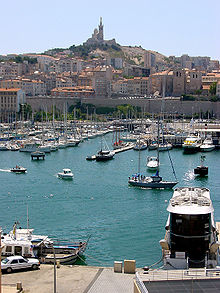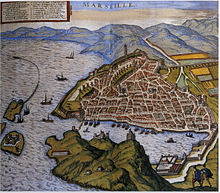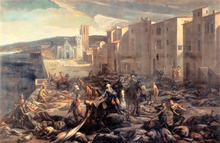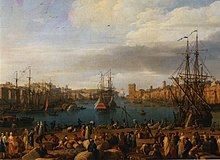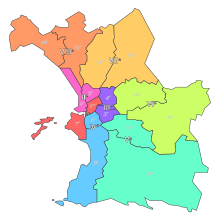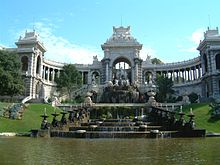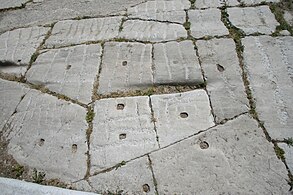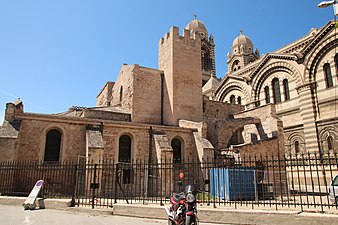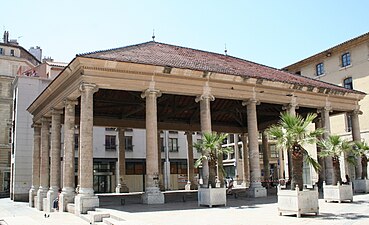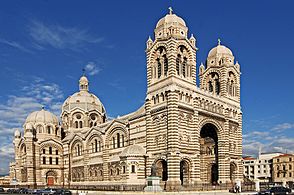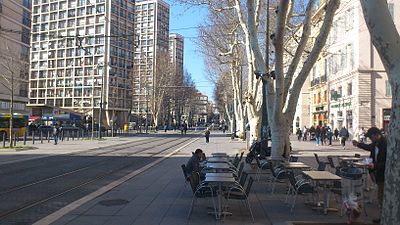Marseilles
Marseille (in French, Marseille pronounced/ma/s transformationj/(![]() listen) Local pronunciation:[ma] motivating](
listen) Local pronunciation:[ma] motivating](![]() listen)in the West, Marselha pronounced[moaning] [ma]шsij]]) is a port city of southern France, capital of the department of Bocas del Ródano and the region of Provence-Alpes-Costa Azul.
listen)in the West, Marselha pronounced[moaning] [ma]шsij]]) is a port city of southern France, capital of the department of Bocas del Ródano and the region of Provence-Alpes-Costa Azul.
Marseille is, with its 859,543 inhabitants, the second most populous city in the country after Paris. It is the main economic center and the largest metropolis in the French Midi, bringing together close to 1,605,000 inhabitants in its urban area, the third largest in the country, after those of Paris and Lyon. It is the most important commercial port in the French Mediterranean and in the whole of France, one of the most important in the entire Mediterranean, third in importance in Europe after Rotterdam and Antwerp, a center of important industrial activity specializing in petrochemicals and oil refining, shipbuilding and various industries, it is also a communications hub where the routes between Paris, Italy, Switzerland and Spain come together. Marseille is the seat of an archdiocese and of the University of Aix-Marseille, founded in 1409.
Marseille developed under the name Massalia as a trading colony founded by Phocian sailors around 600 BC. C., preserving the oldest remains of French viticulture introduced in the IV century B.C. Seat of a viscountcy in the IX century, later dependent on the county of Provence, it was incorporated into the crown of France in 1481 and took advantage of its strategic alliance with the Ottoman Empire during the Renaissance and the Old Regime for its growth. After the Revolution that gave the name of the Marseillaise, the military march that later became one of the national symbols of France, the city was the scene of the so-called White Terror and during the XIX, scene of rapid progress with French colonial expansion into Algeria and the opening of the Suez Canal. It was partially destroyed during World War II and one of the targets of Operation Dragoon. Traditional place of passage for migratory flows that gradually increased the multicultural character of the city, the economic crisis of the 1970s nevertheless caused a notable drop in the population, the loss of purchasing power and the accentuation of social conflicts in the last quarter of the XX century to gradually recover as one of the most important cities in the Euro-Mediterranean region.
Symbols
The coat of arms and the flag of Marseille are traditional symbols representative of the city and have their origins in the Middle Ages. The coat of arms or heraldic description is formulated as follows:
In the field of argen or silver, a cross of azur
The oldest surviving depiction of the Marseille coat of arms is found in an illuminated manuscript, dated to the late 13th century or early from the XIV where it appears reproduced in evocation of the time of the crusades. This traditional coat of arms was disseminated in documents and numismatic coinage until from the XVI century, when printing increased its distribution. The official local architecture and the municipal imagery of which numerous examples are preserved also served as a means of dissemination.
The subsequent evolution of heraldry enriched, in the image of dynastic coats of arms, the complexity of the sign by including, according to the artistic tastes of each era, exterior ornaments. Colbert's edict of July 10, 1699, which regulated the armories of the Kingdom of France, confirmed the use of the traditional coat of arms, until after the Revolution, the Constituent Assembly abandoned by a suppression decree of June 21, 1790, the heraldic tradition considered as representative of the class customs of the Old Regime.
When the rehabilitation of the use of municipal coats of arms was approved by imperial decree in 1809, the Marseillaise corporation of that time included, together with the cross, the figures of some bees and a ship, but with little diffusion.
On November 25, 1815, in the time of Louis XVIII, the use of the traditional shield was resumed, to which were added as tenants or animal ornamental figures, a lion with a caduceus, a symbol of Mercury, and a bull with a trident to which a mural crown was added from 1833. From 1883 new additions such as a cornucopia and the Massilia civitas currency spread. Another Latin motto, Actibus immensis urbs fulget Massiliensis, is also used in some performances: "The City of Marseille shines for its great deeds".
History
Prehistory and Classical Antiquity
Various sites and archaeological studies of different settlements attest to the continuous human presence in Marseille since prehistoric times. Paleolithic cave paintings in the Cosquer underwater cave, near the calanque of Morgiou, dated between 27,000 and 19,000 BCE C., testify to the human presence in the Marseille area for more than 30,000 years.[citation required] In the archaeological site of the Saint-Charles hill, already in the urban center, remains of houses and brick constructions from the Neolithic period have been found, around the 6th millennium BC. C., a period coinciding with the colonization scenario by navigating-agricultural peoples originating from the eastern Mediterranean who introduced agriculture, livestock, pottery and stone polishing work since then in the area of Marseille and southern France..
The date of its foundation was 600 B.C. C. as a Greek polis is given by different ancient authors with variations and by archaeological findings. The reason is unknown, but Justin and Aristotle mention a founding myth about a marriage between the Greek Protis (Euxenus) and the local princess Giptis (Petta).
According to the chronicles of Thucydides, Greeks from Phocea, on the Anatolian peninsula, undertook the founding of the commercial establishment or emporion of Masalia (Μασσαλία) around 600 BC. C., although the circumstances and the precise date of the foundation of this colony remain imprecise. From there the Greeks traveled up the Rhone to the source of the Danube, where they encountered the Celtic tribes and traded with them.
The Masaliots founded other settlements on the coast of the Iberian Peninsula such as Emporion and Hemeroscopio. The cult of Artemis Ephesia in Masalia was prominent in such a way that they spread her cult in those later colonies and even the image of Artemis that the Romans had on the Aventine Hill it had been made taking as a model that of Artemis that the Masaliots had. There was also a sanctuary of Apollo Delphinius and a temple of Athena with a wooden xoana of the goddess.
Masalia was also the starting point for the spread of Hellenistic civilization and its writing among the Gallic and Northern European peoples, who learned to transcribe their own language in Greek characters. Historian Jean-Louis Brunaux says that the druids were the main beneficiaries of this script for trade and scientific notation.
The subsequent development of Masalia, which would reach a significant number of inhabitants and the category of polis (city state), turned it into a Greek port of reference in Western Europe, later an ally of the Roman Republic in its disputes with Etruscans, Celts and Carthage. The Greek colony prospered thanks to its position as a trade bridge between Rome and the peoples of the interior of Gaul, facilitating the exchange of manufactured goods, slaves and, particularly, wine whose production and cultivation in Marseilles dates back to the century IV a. C., as revealed by excavations on the Saint-Charles hill with the discovery of the oldest viticulture substrates discovered in France. In 49 BC. C., as a result of its support for the party of Pompey the Great in its confrontation with Julius Caesar, was annexed to Rome by the latter after defeating and capturing his fleet, adopting the Latin name of Massilia.
The Roman administration respected the foundation built by the Greeks for the benefit of the development of the city, as attested by the archaeological sites that show expansion works, also providing novel infrastructures such as the public sewer system, of which Massilia was the first town in the Galias to be equipped. Homeland of the famous sailor Pytheas, Massilia was governed by a council of 15 senators chosen from among the 600 in the Senate, although effective control was held by three of them[citation needed].
According to Catholic tradition, Mary Magdalene spread Christianity in Provence from Massilia together with Lazarus of Bethany who would be, according to some authors, the first bishop of the diocese of Marseille. From the period of Christian expansion, the epitaph of the probable martyrs Volusianus and Fortunato, considered the oldest of the Christian inscriptions.
Middle Ages
After the collapse of the Western Roman Empire in the V century, the city came to be ruled by the Visigoths, that they ceded it to the Ostrogoths after the battle of Vouillé in 507, to prevent it from falling into the hands of the Franks, who nevertheless ended up occupying it.
At the beginning of the 8th century, the destruction of the Hispano-Visigothic kingdom by the Umayyad Caliphate and the establishment of its power in the Iberian Peninsula, began a period of dispute for control of Western Europe with the Carolingian Empire, which affected the development of Marseille and the other free towns on the Mediterranean coast, mainly in the first half of the century IX, with the phenomenon of harassment of trade routes by piracy. Marseille was attacked and sacked twice in that period by Muslim troops sent from al-Andalus, in 838 and 846. The economic decline is manifested in that throughout the century X, Marseille could not see its municipal privileges confirmed, but it was recovering once integrated into the possessions of the counts of Provence. In 1262, the city revolted under Hugues des Baux, brother of Barral des Baux and Boniface VI of Castellana against the Angevins, but was subdued by Charles of Anjou. In 1347, the city was one of the sources of penetration into Europe of the devastating epidemic of the Black Death, due to its status as a port, resulting in deaths of around 50,000 of its 90,000 inhabitants. Still without recovering from the demographic disaster, the city is attacked and sacked for three days in 1423 by the fleet of Alfonso V of Aragon, in response to the claims of Louis III of Naples to regain control of the territories of southern Italy.
In 1437, Renato I of Naples, who succeeded his father Louis II of Naples as King of Sicily and Duke of Anjou, arrived in Marseilles and established himself as one of the wealthiest settlements outside of Paris. Marseille was later used by the Duke of Anjou as a strategic maritime base in the reconquest of his kingdom of Sicily. King René, who wanted to provide the entrance to the port with a solid defense, decided to build on the ruins of the old Maubert tower and establish a series of walls that protected the port. Jean Pardo, an engineer, conceived the plans and Jehan Robert, a mason from Tarascon, carried out the work. Construction of the city's new defenses took place between 1447 and 1453. Trade flourished in Marseilles also in this period as the guild began to establish a position of power within the city's merchants. Renato also founded the Fishermen's Corporation.
Marseille was united with Provence in 1481 and then incorporated into the Kingdom of France the following year, but it soon acquired a reputation as a wayward city vis-a-vis the central government.
Renaissance
Some thirty years after his incorporation, Francisco I visited Marseilles, attracted by his curiosity to see a rhinoceros that King Manuel I of Portugal sent to Pope Leo X; ship that sank after leaving the island of If. As a result of this visit, the castle of If fortress was built, which was not enough to prevent a siege by the army of the Holy Roman Empire a few years later. Towards the end of the 16th century Marseille suffered another outbreak of the plague, which contributed to the founding of the hospital of the Hotel-Dieu. A century later, King Louis XIV had to go to Marseille at the head of his army, in order to annul the local uprising against the governor. As a consequence, the two forts of San Juan and San Nicolás were raised above the port and a large fleet was established in the port.
18th and 19th centuries
Over the course of the 18th century, the port's defenses were improved and it became more important as a military port in the Mediterranean. In 1720, the Great Plague of Marseilles, a variant of the Black Death, caused 100,000 deaths in the city and surrounding provinces.
Jean-Baptiste Grosson, royal notary, wrote from 1770 to 1791 the historical almanac of Marseille, Recueil des antiquités et des monumentos marseillais qui peuvent interesser l'histoire et les arts, (Collection of antiquities and monuments of Marseille that may be of interest to history and the arts), which for a long time was the main resource on the history of the city's monuments.
The local population enthusiastically embraced the French Revolution, and 500 volunteers marched on Paris in 1792 to defend the revolutionary government. On their march from Marseille to Paris they sang a song, which became known as La Marseillaise, today the national anthem of France.
During the 19th century the port facilities were extended and many factories were installed, the city was a place of industrial innovations and growth in the manufacturing industry. The rise of the French Empire and French conquests from 1830 onwards (particularly in Algeria) stimulated maritime trade and increased the city's prosperity. Maritime opportunities also increased with the opening of the Charonte (1863) and Rove (1911) canals, connecting the Marseillaise port with the Berre pond and the Rhône delta. And especially significant for maritime trade was the opening of the Suez Canal in 1869. This period in Marseille's history is reflected in many of its monuments, such as the Napoleonic obelisk at Mazargues and the royal triumphal arch at d'Aix..
20th century
During the first half of the 20th century, Marseille celebrated its status as a trade and port of the Empire Through its colonial status from 1906 to 1922, the monumental staircase at the railway station glorifies French colonial conquests. In 1934, Alexander I of Yugoslavia arrived at the port to meet French Foreign Minister Louis Barthou, but was assassinated there by Vlada Georgieff.
During World War II, it was occupied by the Wehrmacht between November 1942 and August 1944 and suffered severe damage. A large part of the city's old quarter was dynamited in a massive clean-up project, in order to reduce the chances of hiding resistance members operating in the densely populated old buildings. The governments of East Germany, West Germany and Italy paid massive reparations, plus compound interest, to compensate civilians killed, wounded, homeless or destitute as a result of the war and to rebuild the city.
Beginning in the 1950s, the city served as a port of entry to France for more than a million immigrants. In 1962 there was a large influx after Algerian independence, which included some 150,000 pieds-noirs. Many of the immigrants they have remained and have given the city a vibrant African quarter with a large market.
Geography
The territory of Marseille forms a kind of amphitheater, open to the sea to the west, while to the north it is closed by the mountain range and picturesque port of l'Estaque (immortalized by the painter Cézanne) and the massif of l&# 39;Étoile, to the east Garlaban, to the southeast Saint-Cyr and Mount Puget, to the south the Marseilleveyre massif, after which the Calanques begin, with large cliffs and small coves of great beauty. The city extends in a strip of 57 km along the Mediterranean and close to half of the communal surface is in undeveloped natural territory.
This makes it one of the least densely populated cities in France. The city has grown around the ancient Greek port, called Le Vieux-Port (The Old Port), particularly in the course of the second half of the century XIX. In fact, Marseilles has witnessed an important development in this era, further stimulated by trade towards the new French colonial empire: Algeria, the Levant and the Far East. The street of the Republic is an example of this urbanism of the Second Empire with its Haussmannian style. Turned towards the sea, the city has long ignored its Provençal past whose only means of communication has been the valley of l'Huveaune.
However, the city has undergone certain changes throughout its history. Urban development has always revolved around the Old Port, located in the Lacydon cove where it was founded in 600 BC. C. by Greek sailors from Focea, in Asia Minor. The ancient city of Massalia expanded its commercial area by setting up various factories in Hyères/Olbia, Antibes and Nice. Historically, the city grew gradually from the north shore of the port to the south, which did not prevent the 17th century from, Louis XIV ordered a major urban restructuring. The monarch expanded the city to the south and built the Galères arsenal. In addition, during his reign, the growth of Marseille overflowed to surpass the Canebière (the main artery of the city) and wide boulevards and straight streets were designed where imposing private houses were built. In turn, the immediate construction of two fortresses is ordered to guard the entrance to the port and which will become, over time, essential monuments of the city: the fort of San Nicolás on the south shore and the fort of San John on the north shore.
It would already be, in the XIX century, when Marseille adopted its current image and design. Important works are completed at the level of modern urbanism and architecture, completed with the new port of Joliette, new and wide fundamental boulevards of the city such as the current street of the Republic and historical buildings of the caliber of the Notre-Dame de la Garde basilica., the Stock Exchange Palace, the Longchamp Palace, the Prefecture, the Arts Palace or the Nueva Mayor Cathedral. During the 21st century, the city has been fully immersed in a new rehabilitation program known as Euroméditerranée, created in 1996. This project pursues a constant and remodeled urban planning that respects and tries to rehabilitate the old town of Marseille, combining it with more modern and avant-garde buildings, always in harmony with the image of the city.
Well known in the area is Cassis, on the outskirts of the city and where the beautiful Les Calanques, the coves of Marseille, are located. Maritime excursions usually cross the Frioul archipelago to reach Callelongue, the largest and most important of the coves. The rest (Mounine, Podestat, La Polidette and Queyrons) are very small and difficult to access, as they skirt the dangerous sheers of the Massif de Marseilleveyre. In front of these tiny coves, a multitude of rocky islands rise up, such as the island of Riou.
Climate
The climate of Marseille is Mediterranean, with mild, humid winters and hot, dry summers. In general, the climatic year in the city is usually mild, since the coldest months, January and February, register temperatures of about 11 °C, while the hottest months are usually July and August, with average temperatures close to 30°C. One of the winds that hits Marseille hard is the mistral, powerful and cold, it gestates in the Alps and makes its appearance, mainly in autumn. Less frequent, although not improbable for that, is the sirocco, a wind coming from the Sahara desert.
The city is one of the sunniest in France, as it enjoys an average of 2,857 hours of sunshine per year. In terms of rainfall, it is distributed somewhat evenly throughout the year, although the season the rainiest is autumn.
| Month | Ene. | Feb. | Mar. | Open up. | May. | Jun. | Jul. | Ago. | Sep. | Oct. | Nov. | Dec. | Annual |
|---|---|---|---|---|---|---|---|---|---|---|---|---|---|
| Temp. max. abs. (°C) | 21.2 | 22.7 | 26.1 | 28.5 | 33.2 | 36.9 | 40.6 | 38.6 | 33.8 | 30.9 | 24.3 | 23.1 | 40.6 |
| Average temperature (°C) | 11.8 | 12.9 | 15.5 | 17.9 | 22.2 | 25.7 | 29.1 | 28.7 | 25.0 | 20.4 | 15.0 | 12.6 | 19.7 |
| Average temperature (°C) | 8.4 | 9.1 | 11.2 | 13.4 | 17.5 | 20.8 | 24.0 | 23.7 | 20.4 | 16.3 | 11.5 | 9.3 | 15.5 |
| Temp. medium (°C) | 4.9 | 5.3 | 6.9 | 8.9 | 12.7 | 16.0 | 18.9 | 18.7 | 15.8 | 12.3 | 7.9 | 6.0 | 11.2 |
| Temp. min. abs. (°C) | -10.5 | -14.3 | -7.0 | -3.0 | 0.0 | 7.7 | 9.0 | 8.1 | 2.7 | -1.1 | -6.0 | -11.4 | -14.3 |
| Total precipitation (mm) | 65.4 | 47.3 | 48.7 | 55.2 | 41.0 | 26.8 | 9.1 | 34.0 | 65.5 | 91.6 | 55.2 | 52.3 | 592.2 |
| Precipitation days (≥ 1 mm) | 6.1 | 5.1 | 4.9 | 6.3 | 4.6 | 3.3 | 1.4 | 2.7 | 3.8 | 6.3 | 5.5 | 5.8 | 55.8 |
| Hours of sun | 150.0 | 155.5 | 215.1 | 244.8 | 292.5 | 326.2 | 366.4 | 327.4 | 254.3 | 204.5 | 155.5 | 143.3 | 2835.5 |
| Relative humidity (%) | 75 | 72 | 67 | 65 | 64 | 63 | 59 | 62 | 69 | 74 | 75 | 77 | 68.5 |
| Source: Météo France 1971–2000 raw averages for Longchamp observatory, extremes 1881–31/12/2004 (sun and humidity 1961-1990 at Marignane) | |||||||||||||
Demographics
After a serious crisis in the 1970s and 1980s, the population of Marseille went from 900,000 to 800 000 inhabitants. The French authorities and the French State decided to launch in 1990 and 2000 a vast urban rehabilitation program, with the important Euro-Mediterranean programme, between the Saint-Charles station, the Belle-de-Mai and the old ports. The city wants to unite Europe and the Mediterranean. Today, with more than 800,000 inhabitants, it is the third largest urban unit in France after Paris with 1,418 481 inhabitants (2006), including Aix-en-Provence to the north, Martigues to the west and Saint-Zacharie in the Var department to the east. Marseille inaugurated the XXVI Centenary Park in the south of the city in 1999 to commemorate that birthday.
| Graphic of demographic evolution of Marseilles between 1800 and present |
 |
INSEE Source |
Immigration
Being one of the most important ports in the Mediterranean Sea, Marseille has been a transit city for many international vessels and has turned the city into a very cosmopolitan city. At the end of the 18th century, approximately half of the population was foreign, from abroad or another place, region or country, whose main nuclei came from Italy (Genoa and Piedmont), Spain and Greece.
Greeks and Italians arrived in the city at the end of the 19th century and during the first half of the XX, being, during this time, 40% of the population of Italian origin. Other groups of different nationalities that arrived in Marseille during the past century were the Russians, in 1917, the Armenians, in 1915 and 1923, the Spanish after the civil war of 1936, immigrants from the Maghreb during the period that included the two great world wars, and the pieds-noirs from the French colonies from Algeria and Comoros. In 2006, the largest ethnic minority in the city, in terms of number of inhabitants, were the North Africans (especially Algerians) who made up 70,000 inhabitants. The second largest minority were those from the Comoros (45,000 inhabitants).
Currently, a third of the total Marseillaise population is of Italian origin, the most represented country in the city very even with native French nationality. In addition, it has the largest number of Corsicans and Armenians in the country. Other significant communities in the city are North African Arabs and Berbers (25% of the total population), Turks, Comorians, Chinese, and Vietnamese.
In 2014, the National Institute of Statistics (INSEE, for its acronym in French) published a study on Thursday, according to which the number of Spanish, Portuguese, Italian, Romanian and Polish immigrants in the south of Marseille has doubled between 2009 and 2012. According to the French Institute, this increase resulting from the financial crisis that affected several European countries in that period, has increased the number of Europeans settled in the south of Marseille. Statistics on Spanish immigrants in France show a growth of 107% between 2009 and 2012, that is, in this period it went from 5,300 to 11,000 people.
Religion
Most of the population of Marseille declares itself Catholic (600,000). The other religions with the most adherents are Islam (between 150,000 and 200,000), the Armenian Apostolic Church (80,000), Judaism (80,000, being Marseille the third city with the largest Jewish population in Europe), Protestantism (20,000), the Orthodox Church (10,000) and Buddhism (3,000).
Economy
Traditionally, Marseille's economy has been busy being the port of the French Empire, connecting French North African colonies like Algeria, Morocco and Tunisia with the people of France. Currently, the old port is one of the main attractions for tourism, which in turn is one of the main sources of income for the city, since there are many cafes, bars and hotels in it. Fishing is still fundamental to the local economy and, of course, to Marseillaise gastronomy. Despite the variety of the city's culinary offer, the fresh catches of the day are a very important claim in the restaurants, bars and terraces of the town.
The economy of Marseille today is dominated by the New Port, perpendicular to the Old. A port for commercial containers and transport to the Mediterranean. Most of the transport that passes through the port is related to oil, making Marseille the most important port in France for this transport and the third in Europe. However, this growth is being slowed down by constant attacks and social awareness regarding oil.
Marseille is an important center of commerce and industry in France, with excellent infrastructure such as roads, port and airport. The Marseille Provence Métropole is the place where hundreds of companies are based, most of them small companies. Among the most important are CMA CGM, the third world company in container transport; the Eurocopter Group, one of the leading manufacturers of helicopters; and the EADS corporation.
Recently, the city has experienced a notable improvement in the service sector. But despite having overcome the crisis that plunged it into during the 1970s, Marseille is still far from the big economies of Paris or the industrial regions of north-eastern France. It is also true that the city was awarded the prize for the most dynamic city in France, granted by the financial newspaper L'Expansion, since since 2000, nearly 7,200 companies have been created in the city.
The city is linked to the Rhône River by a canal and has extensive facilities for air and rail transport: nearby is the large oil port of Fos-sur-Mer, which developed from the 1990s 1960. The industry of the metropolitan area of Marseille is dominated by iron and steel, chemical products, plastic and metal products, ships, refined petroleum, construction materials, alcohol, food industry products and the aviation industry.
Administration
Marseille is divided into 16 municipal districts, which are further divided into quartiers (111 in total). The districts are regrouped in pairs forming 8 sectors and each sector has its own council and its municipal chamber.
Municipal elections are held by sectors. There are 303 councilors in total, two thirds are councilors in the sectors and one third in the municipal government. Number of councilors elected by sector:
| Sector | 1 | 2 | 3 | 4 | 5 | 6 | 7 | 8 | Total |
|---|---|---|---|---|---|---|---|---|---|
| Sector councils | 22 | 16 | 22 | 30 | 30 | 26 | 32 | 24 | 202 |
| Municipal councils | 11 | 8 | 12 | 13 | 15 | 13 | 16 | 12 | 100 |
| Total elected officers | 33 | 24 | 33 | 42 | 45 | 39 | 48 | 36 | 303 |
Culture
Among the cultural and educational institutions of the city, the universities of Aix-Marseille I and II (1970) stand out. The elegant Marseille Opera, built in 1787 and where, for example, Alfredo Kraus, Plácido Domingo and Renata Scotto have performed. Among his illustrious sons, the baroque image maker and sculptor Antoine Duparc stands out.
The city also stands out for being one of the most important capitals of European hip hop. It is also the birthplace and work place of filmmaker Robert Guédiguian, whose works, Marius and Jeanette, won him several awards and good international reviews.
Marseille submitted its candidacy to be the European Capital of Culture in 2013, and was chosen. For this, it had to beat other French and Slovak candidate cities. French cities included Lyon, Saint-Étienne, Nice, Bordeaux, Strasbourg and Toulouse. Marseille's proposal is culture, knowledge and art, both in life and in the city, under the motto "Marseille, city of important cultural mixes."
Museums
Marseille has twenty-six museums, in addition to the Préau des Accoules, the largest number of museums in the country after Paris:
- Museum of European and Mediterranean Civilizations (MuCEM), located in the Fort Saint-Jean, is a national museum created in 2013 and is the most visited museum in the city, having received more than two million people in 2013;
- Marseille history museum that narrates the history of the city from its foundation to the present day and houses the Garden of Vestigios; it has a lot of remains of the Greek and Roman presence in the city;
- Museum of Mediterranean Archaeology and the Museum of African Arts, Oceans and Amerindia, located in the Vieille Charité;
- Museum of the Roman Piers
- Cabinet of Coins and Medals;
- Museum of Natural History and the Museum of Fine Arts, located at the Palais Longchamp;
- Grobet-Labadié museum located on top of Longchamp Boulevard.
- Monticelli foundation, in the fort of Corbières, in the Estaque;
- Museum of Decorative Arts, Faïence and Fashion located in the château Borély;
- Cantini Museum, next to the Palace of Justice, a museum of modern art that boasts some works by Picasso;
- Museum of Contemporary Art;
- Frac Provence-Alpes-Côte d'Azur
- Tour-Panorama (contemporary art)
- Notre-Dame-de-la-Garde Museum;
- Musée du Terror marsellés, located in the Château-Gombert;
- Marina museum;
- Château de la Buzine (Museum of Cinema);
- Mediterranean Villa;
- MAMO at the Cité radieuse de Le Corbusier;
- Memorial of death camps;
- La Marsellesa Memorial;
- Moto museum;
- Museum of Provence and the museum of the saint Marcel Carbonel are private museums.
Many of them were renovated or created in 2013 on the occasion of the European Capital of Culture (Marseille-Provence 2013).
Outstanding architecture and monuments
Prehistory and Antiquity
Located in the south of the city, the Cosquer cave, discovered in 1992, is an ornate Paleolithic cave, frequented between 27,000 and 19,000 before the present, whose entrance under the sea makes access difficult.
Despite being the oldest city in France, Marseille preserves few vestiges of ancient times. In the late 1960s, archaeologists discovered and unearthed part of the city's Hellenistic buttresses and walls. Few traces still remain of the Greek or Roman city. The most visible are those of the old port, located northeast of the current Old Port, in the Garden of Vestiges, at the heart of the Marseille History Museum. There you can find remains of Greek fortifications, of the defensive tower, of the Roman road, of the fresh water basin or of the funerary terraces.
- Old Vestiges
Middle Ages
As the city has always been rebuilt upon itself through urbanization, medieval Marseille is, in the words of Thierry Pécout, a “ville de papier” (paper city) that only historians and archaeologists can revive in the face of demise of numerous medieval buildings and the remodeling of the city in modern and contemporary times.
Next to the Cathedral of La Mayor, part of the old medieval cathedral and vestiges of a previous paleo-Christian church are preserved.
St Victor's Abbey, the oldest parts of which date back to the 11th century, was built on what is perhaps the oldest Christian place of worship in France. In crypts from the 11th century, on which the church was built in the XIII, there is an image of the Virgin Mary that is considered the work of Saint Luke. The Notre-Dame de la Galline chapel would have been built on a place of worship dating from 1042.
La Vieja Mayor, the city's old cathedral, was built from the 12th century on the site of a first church dating from late antiquity.
The church of San Lorenzo, built in the XIII century in the Provençal Romanesque style, is the parish of the fishermen of Marseilles.
- Middle Ages Buildings
Renaissance and classicist period
Of the two forts built at the entrance to the Old Port by Louis XIV to oversee the city in the 17th century, only Fort Saint-Nicolas is still occupied by the army. Fort Saint-Jean, whose square tower was built as early as the 15th century by René of Anjou, is now occupied by the Museum of European and Mediterranean Civilizations (MuCEM). From the arsenal of the galleys that occupied the south bank of the port, only the captaincy remains today.
- Renaissance buildings and the century of the Lights
Bastides
Bastides are a characteristic element of the Marseillaise terroir. They were second homes that the Marseille bourgeoisie had in the countryside, on the outskirts of the city. It is estimated that in 1773 there were more than 6500. Having a "bastide" It was such a widespread practice that Stendhal considered that "this is why there are no shows on Saturday: that day, as soon as the Stock Market ends, everyone flees to their Bastide [...]"
There are still 254 registered today, but if some like La Buzine have been renovated or reconverted, many others are in decline and threaten ruin.
Second Empire
Many Marseille monuments were built from the second half of the XIX century, while the city was experiencing an economic boom, especially during the Second Empire. This is the case of the Palacio del Faro (1858), the Palacio de la Bolsa (1860), the Hotel Prefectura (1866) and the Church of the Reformed (1886), later and in neo-Gothic style.
Henri-Jacques Espérandieu is the author of several famous monuments such as the Longchamp palace (1862), the Notre-Dame de la Garde basilica (1864) and the Palace of Arts (1864). Built between 1855 and 1864 with Henri Révoil, Notre Dame de la Garde, also known as the Good Mother, is famous for its Romano-Byzantine architecture and its gilt copper statue of the Virgin and Child that dominates the building, the work of the sculptor Eugène-Louis Lequesne.
Another Romano-Byzantine building, the Cathedrale de la Major, in the La Joliette quarter, was completed in 1893 on the site of the former 18th-century Major XII, of which the choir and palace still survive.
At this time the rue de la République was also opened, adorned with Haussmannian buildings and connecting the Old Port with the new port of La Joliette.
- Second Empire Buildings
Industrial heritage
Marseille bears many traces of its industrial history and many of these sites are being converted. The cigar manufactory, built in 1868 in the Belle de Mai district, is, after being disused for a long time, occupied by a cultural site, the Municipal Archives and a Pôle média.
In the Joliette neighborhood, the Arenc grain silo has been converted into a performance hall and the huge docks have been completely renovated and converted into offices and a shopping mall.
There are only three factories in operation in the Quartiers Nord of the soap industry. Others, sometimes in disuse, appear scattered in the north and east of the city.
Modern architecture
The architect Fernand Pouillon built many buildings in the years after World War II. He was in charge of the reconstruction of the Old Port district destroyed during the rafle (the famous buildings of Pouillon) or the Sanitary Control, now occupied by the Regards de Provence museum.
In 1952, Le Corbusier built his Cité radieuse (locally called "Le Corbusier" or the "maison du fada"), an example of Brutalist architecture and his Unité d'Habitation principle. The building can be visited and its panoramic roof-terrace houses a contemporary art museum, the MaMo.
- Modern buildings
Postmodern architecture
As part of its urban renewal, the city today sees the construction of buildings of postmodern architecture, such as the Museum of European and Mediterranean Civilizations (MuCEM), the CMA-CGM tower or the Villa Mediterránea.
Tourism
Marseille is the most important city in France in terms of coastal tourism, due to its good climate and its beaches. But it is also home to a large number of historical buildings that attract a multitude of tourists every year, as well as its important and significant seaport. Most of the main historical sites essential for tourists are located in the 1st, 2nd, 6th and 7th districts.
Places of Interest
- The Basilica of Santa María la Mayor is a Romanesque-Byzantine building unique in its genre in France, which evokes oriental memories. It consists of two churches, the oldest, Romanesque style, dates back to the centuryV although it was rebuilt between the centuries XI and XII. The other was erected in the mid-centuryXIV by the architects Vaudoyer and Espérandieu in Byzantine style, with fine Italian stones and marbles.
- Notre-Dame de la Garde is a smaller basilica and is located in a strip of land that is projected west of the bay, 162 m high above the old port. It was built where the chapel of the Garde had been settled for centuries. The current building was designed by Espérandieu and completed by Henri Revoil that incorporates a sumptuous mosaic decoration. It is crowned by a golden effigy of the Virgin Mary, one of the most significant prints in the city. It is crowned by a golden statue of the Virgin Mary, who ordered to build Saint Eugene de Mazenod, bishop of the city and founder of the Missionary Oblates of Mary Immaculate.
- The castle of If is a fortification erected in the bay of the city between 1527 and 1529 on the small island of If of the archipelago of Frioul for the protection of the city of Marseille. From the centuryXVII the building became a state prison although it ended up being a tourist attraction. Boats from the old port link daily with the island. If Castle is described in the novel by Alexander Dumas The Count of Montecristo.
- The forts of San Juan and San Nicolás delimit the entrance to the old port. The Fort San Juan was built from the centuryXII until 1365 and was raised to defend the north gate, the oldest in the city. The fort Saint Nicholas was built successively, was never used for war purposes and today is one of the most beautiful citadels of Provence.
- The City of Marseille is a small building built in 1653. Built in the image of the Genoese palaces of the time, it is the work of an Italian architect, whose name is not known. The building is known by the old Marselleses as “La Loge” derivation of the Italian word Loggia. It was one of the few buildings that survived the destruction of the area, under the German occupation.
- The Palace of the Marseille Stock Exchange is the first building erected within the framework of the Second Empire from 1852 to 1854. It was designed by the architect Pascal Coste. This is the starting point of the great wave of construction of public buildings in Marseilles in the middle of the centuryXIX. The building houses the seat of the Chamber of Commerce since its inauguration on September 26, 1852 with the presence of Louis-Napoléon Bonaparte. The sculpted decoration is entirely dedicated to the glorious history of the Marshal trade.
- The Longchamp Palace was inaugurated in 1869 to commemorate the arrival of the waters of the Durance River canal to Marseille. The city lacked water and in 1839 it began to build on the canal that would bring the waters to the city, following the election of the project of the road engineer Franz Mayor de Montricher. The building houses the Museum of Fine Arts and the Museum of Natural History, today under the supervision of the Ministry of Higher Education and Research. The Longchamp Palace was declared a Historic Monument in 1999.
- The Abbey of Saint Victor de Marseille (in French: Abbaye de Saint-Victor de Marseille) was founded in the centuryV by Saint Jean-Cassien. It was built near the tombs of the martyrs of Marseilles, among whom was St. Victor of Marseille (303 or 304) who gave the abbey name. For more than 1700 years it is one of the most important places of Catholicism located in southern France and although the monastery was dissolved during the French Revolution, the church is still used.
Neighborhoods
The neighborhoods of Marseille are very popular due to their charm. One of the most important is the Le Panier neighborhood, full of artisan shops such as bakeries and pastries with typical products from the area. The most important monument in Le Panier is the La Charité building, already mentioned above, an 18th century building that has restaurants and museums such as the one of Mediterranean Archaeology. The neighborhood's star gastronomic product is artisan chocolate, much in demand by the residents of Marseille and tourists. La Chocolatière du Panier is one of the most prestigious and specialized stores in the city.
Place Castellane in the Prado is one of the most active neighborhoods in the city. It became the place chosen by the Marseillaises when the historic center gradually became depopulated. Near the Place de la Prefecture is Cours Julien, known locally as Cours Ju'. It is a square, but also one of the most alternative neighborhoods in the city, where there is also a park and a multitude of paths. In them there are numerous bars, restaurants of all nationalities and bookstores.
Transportation
The city has an international airport, the Marseille Provence airport, located in the commune of Marignane, 27 kilometers from Marseille. It is the third French airport, excluding those of Paris, by passenger traffic, behind those of Nice and Lyon, and the second by traffic load.
It has its own metro, the Marseille Metro, which serves the population through two lines that connect the main points of the city. Line 1 (known for its blue color) is the one between Castellane and La Rose, being inaugurated in 1977. While line 2 (the red one) runs the route Sainte-Marguerite/Dromel and Bougainville and was open to the public for the first time. time between 1984 and 1987. Users also have a tram line. The Saint Charles station is the most important in Marseille, inaugurated in 1848. In 1992, line 1 was extended from Castellane to La Timone, and in 2010 to La Fourragère.
As for the bus, the RTM (Régie des Transports de Marseille) is the city's public transport company. Another coach company is Aubagnais, which has 24 urban lines and connections with 11 peripheral towns. All the lines arrive at a Pôle d' Echanges (exchange stations) where connections are made with the rest of transport such as trains, buses and cars. The Bus du Soleil connect Marseille with the surrounding area.
Bicycle transportation is very common among the Marseillaise population and the companies of the different means of public transport add minimal charges to the transport of cycles on their journeys, as occurs in the SNCF trains. There are several special routes in the city and a wide range of bike rental companies.
Of course, Marseille is also accessible via highways. The A-7, the Autoroute du Soleil (the highway of the sun) connects Marseille with the north and the west, mainly with Lyon. The A-51 between Marseille and Grenoble via Aix-en-Provence, the A-50 that connects Marseille with Toulon and, finally, the Côte d'Azur to the east via the A-8.
Sports
In Marseille the most popular sport is soccer, and the city has its own team, Olympique de Marseille, one of the most successful teams in the country and the only French team to have won the UEFA Champions League, achieved in 1993. It competes in Ligue 1, the first division of national football. It plays its home matches at the Stade Vélodrome, with a capacity for 67,054 spectators, which hosted the two World Cups held in France in 1938 and 1998. In terms of football, it is also known for being the birthplace of the French footballer of Algerian origin Zinedine Zidane and Éric Cantona.
Rugby is another of the sports that has the most followers. The city has a club in this sport, the Marseille Provence XV. Marseille and the Stade Vélodrome have hosted the 2007 Rugby World Cup won by South Africa. The French national rugby team plays its home matches at the aforementioned Vélodrome.
Sailing and cycling are also very popular, the latter since the city is often a stage for the Tour de France.
Far from mass sports, one of the most important sporting events in the city is the Petanque World Cup, which takes place in July and brings together 12,500 span> international players of this sport. Thanks to its kilometers of beaches, Marseille hosts different championships in the summer of beach volleyball, beach rugby and beach soccer.
Twinned cities
Officially, Marseille is twinned with fourteen cities. These are:
- Abidjan (Costa de Marfíl)
- Antwerp (Belgium)
- Pristina (Kosovo)
- Copenhagen, Denmark
- Dakar, Senegal
- Genoa, Italy
- Glasgow, United Kingdom
- Haifa (Israel)
- Hamburg, Germany
- Kōbe, Japan
- Marrakech, Morocco
- Odesa (Ukraine)
- Pireo (Greece)
- Shanghai, China
- Tecomán (Mexico)
- Cartagena, Colombia
- San Cristobal (Venezuela)
In addition, it signed different types of collaborative agreements with twenty-eight cities throughout the world. These cities are:
- Agadir (Morocco)
- Alexandria (Egypt)
- Algiers (Algeria)
- Bamako (Mali)
- Barcelona, Spain
- Beirut, Lebanon
- Cape Town, South Africa
- Casablanca, Morocco
- Yerevan (Armenia)
- Gdansk (Poland)
- Istanbul, Turkey
- Izmit (Turkey)
- Jerusalem (Israel)
- Limassol (Cyprus)
- Punta del Este (Uruguay)
- Lomé (Togo)
- Lyon, France
- Meknes (Morocco)
- Montevideo (Uruguay)
- Arequipa (Peru)
- Yamena (Chad)
- Nice (France)
- Nimes (France)
- Rabat (Morocco)
- Sarajevo (Bosnia-Herzegovina)
- Susa (Tunisia)
- Thessaloniki (Greece)
- Tirana (Albania)
- Tripoli (Libya)
- Tunisia (Tunisia)
European Capital of Culture
| Predecessor: |  European Capital of Culture along with 2013 | Successor: |
Notable people
Contenido relacionado
1471
Villagelanguage
Libertador San Martin
